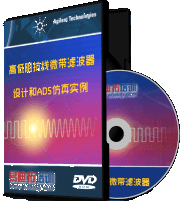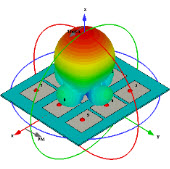SAR Calculation Problems
05-08
I simulated a PIFA antenna in a tissue and obtain the following results but now,thess are my question :
================================================================================
SARCalculation Results
================================================================================
Powerlossdensity monitor used: loss (f=320) [1] at 320 MHz
StimulatedPower [W] (peak): 1
StimulatedPower [W] (rms): 0.5
Averagecell mass [g]: 0.000806696
Averagingmethod: IEEE C95.3
Averagingmass [g]: 1
--------------------------------------------------------------------------------
EntireVolume:
Min(x,y,z) [mm]: -50, -12, -50
Max(x,y,z) [mm]: 50, 38, 50
Volume[mm^3]: 500000
Absorbedpower (rms) [W]: 0.000171709
Tissuevolume [mm^3]: 492320
Tissuemass [kg]: 0.49232
Tissuepower (rms) [W]: 0.000171709
Averagepower (rms) [W/mm^3]: 3.48776e-010
TotalSAR (rms) [W/kg]: 0.000348776
Max.point SAR (rms) [W/kg]: 1.13978
Maximum SAR (rms,1g)[W/kg]: 0.0464041
Maximumat (x,y,z) [mm]: -3.75, 4.6,16.2013
Avg.vol.min(x,y,z) [mm]: -9.62584, -1.27584,10.3255
Avg.vol.max(x,y,z) [mm]: 2.12584, 10.4758,22.0771
- I'm not familar with IEEEC95.3 standar,dose my 1-g SAR result satisfy this standard?
- Which SAR calculations is important :Maximum SAR or average SAR?
================================================================================
SARCalculation Results
================================================================================
Powerlossdensity monitor used: loss (f=320) [1] at 320 MHz
StimulatedPower [W] (peak): 1
StimulatedPower [W] (rms): 0.5
Averagecell mass [g]: 0.000806696
Averagingmethod: IEEE C95.3
Averagingmass [g]: 1
--------------------------------------------------------------------------------
EntireVolume:
Min(x,y,z) [mm]: -50, -12, -50
Max(x,y,z) [mm]: 50, 38, 50
Volume[mm^3]: 500000
Absorbedpower (rms) [W]: 0.000171709
Tissuevolume [mm^3]: 492320
Tissuemass [kg]: 0.49232
Tissuepower (rms) [W]: 0.000171709
Averagepower (rms) [W/mm^3]: 3.48776e-010
TotalSAR (rms) [W/kg]: 0.000348776
Max.point SAR (rms) [W/kg]: 1.13978
Maximum SAR (rms,1g)[W/kg]: 0.0464041
Maximumat (x,y,z) [mm]: -3.75, 4.6,16.2013
Avg.vol.min(x,y,z) [mm]: -9.62584, -1.27584,10.3255
Avg.vol.max(x,y,z) [mm]: 2.12584, 10.4758,22.0771
Hi, 1g Average SAR is more important than unaveraged SAR.
1) Thermal effect is related to 1g average.
2) There is singularity from numerical simulation. So the peak SAR point is not necessarily worst heating location.
相关文章:
- CST 仿真SAR的人头模型 (05-08)
- 关于天线SAR的计算 (05-08)
- cst仿真手机sar例子中的值为5w/kg。对吗? (05-08)
- 关于CST的SAR仿真,求助! (05-08)
- SAR功能不可用? (05-08)
- CST里的SAR calculation 怎么不可用呢 (05-08)
射频专业培训教程推荐











